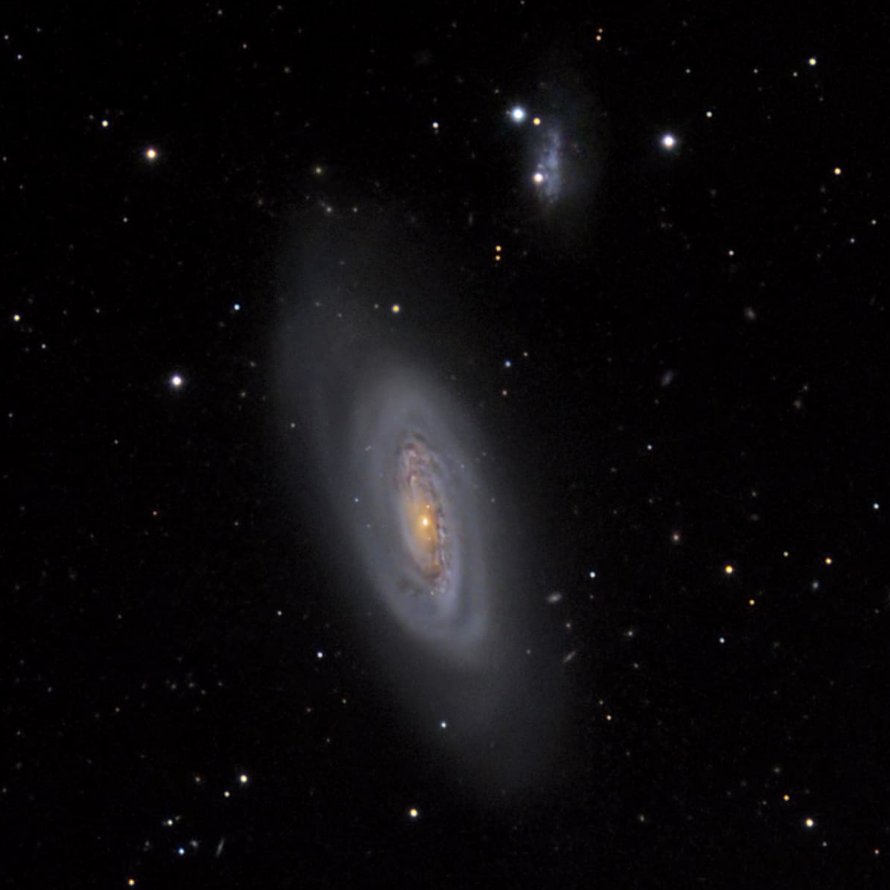M90 (NGC 4569)
Messier 90 (NGC 4569) is a spiral galaxy located in the constellation Virgo in the Virgo Cluster of galaxies. M90 is 58700000 light years away from Earth.
M90 is best viewed during late spring, is magnitude 10.3, and can be viewed with small telescope. M90 is 9.5' x 4.4' in apparent size. For reference, the full moon is 30'.
Observing difficulty: Hard
- Name:
- Type:
- spiral galaxy
- Constellation:
- Virgo
- NGC or IC:
- NGC 4569
- Magnitude:
- 10.3
- Viewing:
- small telescope
- Size:
- 9.5' x 4.4'
- Distance (light years):
- 58700000 LY
- RA:
- 12h 36.9m
- Dec:
- 13 10'
- Season:
- late spring
- Galaxy group:
- Virgo Cluster
- Messier Marathon #:
- 57
* The naked eye can see up to magnitude ~7-8 objects under ideal dark sky conditions.
An Insight into the Spiral Galaxy of the Virgo Cluster
Messier 90 (M90) is an intriguing spiral galaxy located within the constellation Virgo. This celestial body is part of the famous Virgo Cluster of galaxies, which is the nearest large cluster of galaxies to the Milky Way. It was first documented by French astronomer Charles Messier in 1781. M90 presents astronomers with a rich field of study due to its distinct features, such as its highly defined spiral structure, blue arms, and the absence of recent star-forming activities.
Characteristics of Messier 90
M90 is classified as an intermediate spiral galaxy, denoted as type SAB(rs)ab in the Hubble sequence of galaxy types. This classification indicates that the galaxy has a slight bar-like feature at its core, with tightly wound, well-defined spiral arms that appear almost circular. These arms are a brilliant blue color, contrasting with the bright, yellowish core of the galaxy.
Interestingly, M90 exhibits an anomaly known as "anemic spiral arms." This term refers to the significantly low star-forming activity in its spiral arms compared to typical spiral galaxies. This feature, coupled with the galaxy's blue arms, hints at a complex and fascinating history of star formation and evolution within M90.
Magnitude and Size
The apparent magnitude of Messier 90 is approximately 9.5, which, similar to many other deep-sky objects, renders it invisible to the naked eye but accessible to modest amateur telescopes and binoculars under dark skies. Spanning around 9.5 x 4.4 arcminutes in the sky, this intermediate spiral galaxy is estimated to be 60 million light-years away from Earth.
Finding and Observing Messier 90
Finding M90 requires a bit of sky-charting. The galaxy is located in the Virgo constellation, which is most easily observed during the spring months from the Northern Hemisphere. Within this constellation, M90 is situated near several other Messier objects, including M87, M89, and M91, forming part of the Virgo Cluster. The nearby bright star Vindemiatrix (Epsilon Virginis) can serve as a useful guidepost in locating M90.
Though M90 may appear as a faint, elongated smudge in smaller telescopes, observers with larger telescopes and ideal viewing conditions may discern the galaxy's bright center and elongated shape. The intricate details of the spiral structure and the color contrasts of M90 are best appreciated through long-exposure astrophotography.
M90, with its anemic spiral arms and contrasting colors, offers a fascinating subject for astronomers, amateurs and professionals alike, interested in studying galaxy structures and star formation histories. It stands as a testament to the diversity and complexity of our universe.



